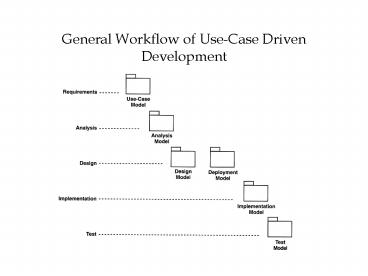General Workflow of Use-Case Driven Development - PowerPoint PPT Presentation
Title:
General Workflow of Use-Case Driven Development
Description:
General Workflow of Use-Case Driven Development Use-Case Overview Objectives of requirements capture Identify true requirements Suitable representation for users ... – PowerPoint PPT presentation
Number of Views:194
Avg rating:3.0/5.0
Title: General Workflow of Use-Case Driven Development
1
General Workflow of Use-Case Driven Development
2
Use-Case Overview
- Objectives of requirements capture
- Identify true requirements
- Suitable representation for users, customers,
developers - Why use-case?
- Systematic and intuitive means of capturing
functional requirements - Drive the whole development process
- Definition of use case
- Specification of a sequence of actions, including
variants, that the system can perform and that
yields an observable result of value to a
particular type of users (actor)
3
Capturing Use Cases
- Use case model represents the functional
requirements - From users perspective (fig. 3.3)
- Focus on interactions of the system with
environment (actors) - Use cases also used as placeholders for
nonfunctional requirements
4
Example
5
Creating Analysis Model From Use Cases
- Analysis model constructed incrementally as more
use cases analyzed - Select use cases to be realized in analysis model
- Build system as a structure of classifiers
(analysis classes) and relationship between them - Describe collaborations that realize use cases
- Pick next set of uses cases for the next iteration
6
Example
7
Evolution of Analysis Model
8
Describing Use Case Realization Using
Collaboration Diagram
9
Use Case Realization - Traceability
10
Use Case Realization in Different Models Serve
Different Purposes
11
Use Case Realization In Terms of Design Classes
12
Realization of Use Cases - Dynamic Model for
Design Classes(Compare with Fig. 3.6)
13
Managing Complexity -Grouping Objects Into
Subsystems
14
Creating Implementation Model From Design Model































